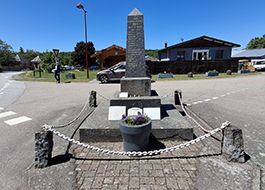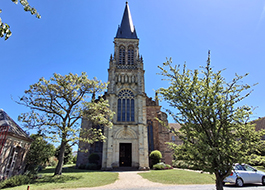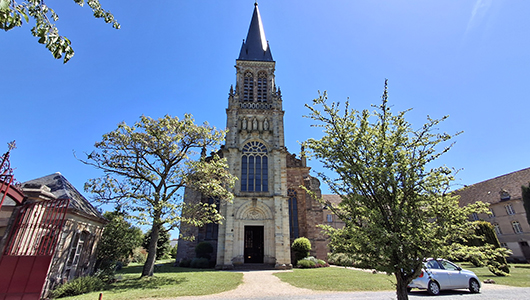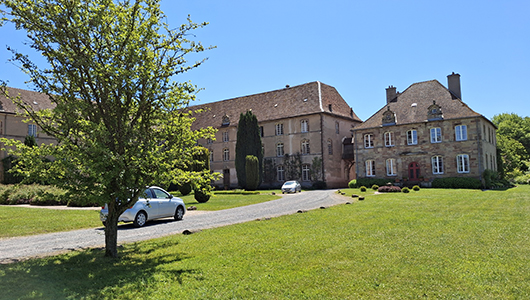Autrey
Durée visite à pied : 15 minutes
Durée visite à vélo : 15 minutes
Le nom de la localité est attesté sous les formes d’Altirei en 1101. En 1149, le cardinal Étienne de Bar, évêque de Metz fonde l’abbaye d’Autrey. Il y installe une communauté de chanoines réguliers. Le dernier abbé d’Autrey, Barthélemy-Louis-Martin Chaumont, devint le premier évêque du diocèse de Saint-Dié créé en 1777. En 1982, après 10 ans d’abandon, Mgr Vilnet, évêque de Saint-Dié, appelle la Communauté des Béatitudes à redonner vie à l’Abbaye.
The name of the locality is attested in the form Altirei in 1101. In 1149, Cardinal Étienne de Bar, Bishop of Metz, founded Autrey Abbey. He established a community of canons regular there. The last abbot of Autrey, Barthélemy-Louis-Martin Chaumont, became the first bishop of the Diocese of Saint-Dié, created in 1777. In 1982, after 10 years of neglect, Bishop Vilnet of Saint-Dié called upon the Community of the Beatitudes to revive the Abbey.
Der Ortsname ist in der Form „Altirei“ im Jahr 1101 belegt. 1149 gründete Kardinal Étienne de Bar, Bischof von Metz, die Abtei Autrey. Er errichtete dort eine Gemeinschaft von Regularkanonikern. Der letzte Abt von Autrey, Barthélemy-Louis-Martin Chaumont, wurde der erste Bischof der 1777 gegründeten Diözese Saint-Dié. Nach zehn Jahren der Vernachlässigung rief Bischof Vilnet von Saint-Dié 1982 die Gemeinschaft der Seligpreisungen dazu auf, die Abtei wiederzubeleben.

Les habitants et les habitantes d’Autrey s’appellent les Altériciens et les Altériciennes.
The inhabitants of Autrey are called Altéricians and Altériciennes.
Die Einwohner von Autrey werden Altéricians und Altériciennes genannt.
Les points de visites

.
Dédié aux natifs d’Autrey, victimes de la Grande Guerre, cet obélisque en granit rend également hommage à deux enfants du village morts, l’un à Madagascar en 1894 et l’autre au Tonkin la même année ; c’est-à-dire dans des conflits coloniaux. Trois noms de soldats ont été rajoutés, plus tard, aux quinze premiers soldats morts en 1914-1918.
Dedicated to the natives of Autrey, victims of the Great War, this granite obelisk also pays tribute to two children from the village who died, one in Madagascar in 1894 and the other in Tonkin the same year; that is, in colonial conflicts. Three soldiers’ names were later added to the first fifteen soldiers who died in 1914-1918.
Dieser Granitobelisk ist den Einwohnern von Autrey gewidmet, die im Ersten Weltkrieg umkamen. Er erinnert auch an zwei Kinder des Dorfes, die 1894 in Madagaskar und im selben Jahr in Tonkin – also in Kolonialkonflikten – ums Leben kamen. Drei weitere Namen wurden später zu den ersten fünfzehn Soldaten hinzugefügt, die zwischen 1914 und 1918 starben.
.

.
Fondée en 1149 par le cardinal Étienne de Bar, l’abbaye Notre-Dame d’Autrey est confiée aux chanoines de saint Augustin. Elle devient un lieu de pèlerinage réputé grâce à une relique de saint Hubert. Ravagée par les guerres, elle est restaurée entre 1537 et 1545 par l’abbé Stevenel, qui reconstruit le chevet, le transept et deux chapelles dans un style mêlant gothique et Renaissance. La chapelle Saint-Hubert est l’un des joyaux de la Renaissance vosgienne. Après de nouveaux troubles au XVIIe siècle, l’ensemble est reconstruit par les chanoines réformés de la congrégation de Notre-Sauveur. En 1777, l’abbaye perd son titre. Vendue comme bien national en 1792, elle devient une tréfilerie, sauvant ainsi les bâtiments. En 1856, l’archevêque Caverot y installe un séminaire, remplacé plus tard par un hospice, puis un hôpital de guerre. Il redevient séminaire de 1931 à 1974. Depuis 1982, la Communauté des Béatitudes y réside. Le site abrite aussi un parc botanique de 2 500 essences et une pépinière. Enfin, l’abbaye a donné son nom à une bière artisanale brassée localement.
Founded in 1149 by Cardinal Étienne de Bar, the Notre-Dame d’Autrey Abbey was entrusted to the canons of Saint Augustine. It became a renowned place of pilgrimage thanks to a relic of Saint Hubert. Ravaged by wars, it was restored between 1537 and 1545 by Abbot Stevenel, who rebuilt the apse, the transept, and two chapels in a style combining Gothic and Renaissance. The Saint-Hubert Chapel is one of the jewels of the Vosges Renaissance. After further unrest in the 17th century, the complex was rebuilt by the reformed canons of the Congregation of Our Saviour. In 1777, the abbey lost its title. Sold as national property in 1792, it became a wire-drawing mill, thus saving the buildings. In 1856, Archbishop Caverot established a seminary there, later replaced by a hospice, then a war hospital. It became a seminary again from 1931 to 1974. Since 1982, the Community of the Beatitudes has resided there. The site also houses a botanical park with 2,500 species of trees and a nursery. Finally, the abbey has lent its name to a locally brewed craft beer.
Die 1149 von Kardinal Étienne de Bar gegründete Abtei Notre-Dame d’Autrey wurde den Kanonikern des Augustinus anvertraut. Dank einer Reliquie des Heiligen Hubertus wurde sie zu einem berühmten Wallfahrtsort. Durch Kriege zerstört, wurde sie zwischen 1537 und 1545 von Abt Stevenel restauriert, der die Apsis, das Querschiff und zwei Kapellen in einem Stil neu aufbaute, der Gotik und Renaissance vereinte. Die Kapelle Saint-Hubert ist eines der Juwelen der Vogesenrenaissance. Nach weiteren Unruhen im 17. Jahrhundert wurde der Komplex von den reformierten Kanonikern der Kongregation unseres Erlösers wieder aufgebaut. 1777 verlor die Abtei ihren Titel. 1792 als Staatseigentum verkauft, wurde sie zu einer Drahtzieherei, wodurch die Gebäude gerettet werden konnten. 1856 richtete Erzbischof Caverot dort ein Seminar ein, das später durch ein Hospiz und dann ein Kriegslazarett ersetzt wurde. Von 1931 bis 1974 diente die Abtei erneut als Priesterseminar. Seit 1982 ist die Gemeinschaft der Seligpreisungen dort ansässig. Auf dem Gelände befindet sich außerdem ein botanischer Park mit 2.500 Baumarten und eine Baumschule. Schließlich gab die Abtei einem lokal gebrauten Craft Beer ihren Namen.






